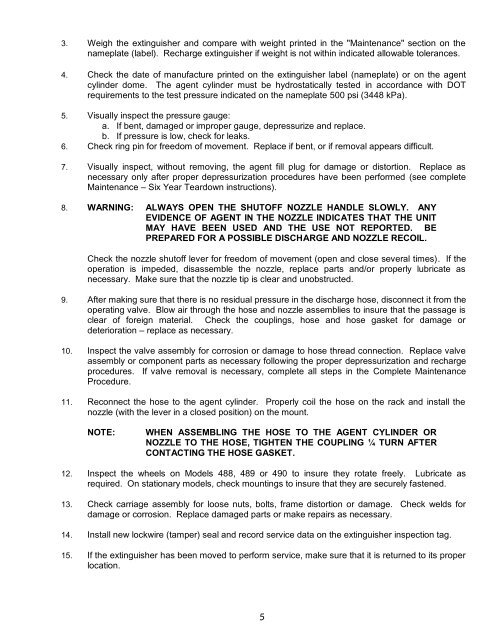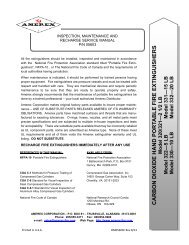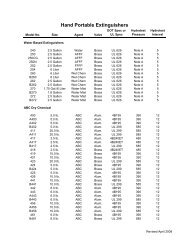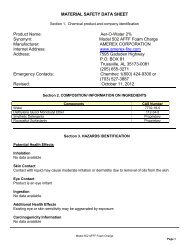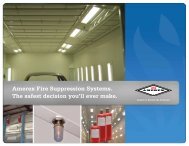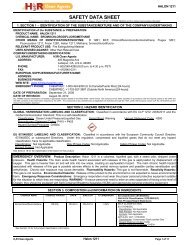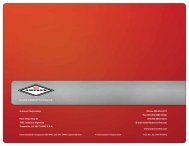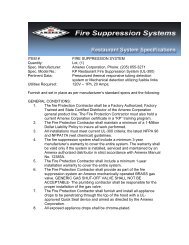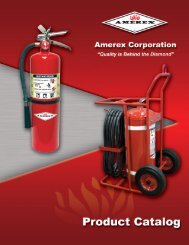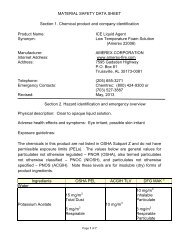Manual for 125-150 lb Stored Pressure - Amerex Corporation
Manual for 125-150 lb Stored Pressure - Amerex Corporation
Manual for 125-150 lb Stored Pressure - Amerex Corporation
Create successful ePaper yourself
Turn your PDF publications into a flip-book with our unique Google optimized e-Paper software.
3. Weigh the extinguisher and compare with weight printed in the "Maintenance" section on the<br />
nameplate (label). Recharge extinguisher if weight is not within indicated allowable tolerances.<br />
4. Check the date of manufacture printed on the extinguisher label (nameplate) or on the agent<br />
cylinder dome. The agent cylinder must be hydrostatically tested in accordance with DOT<br />
requirements to the test pressure indicated on the nameplate 500 psi (3448 kPa).<br />
5. Visually inspect the pressure gauge:<br />
a. If bent, damaged or improper gauge, depressurize and replace.<br />
b. If pressure is low, check <strong>for</strong> leaks.<br />
6. Check ring pin <strong>for</strong> freedom of movement. Replace if bent, or if removal appears difficult.<br />
7. Visually inspect, without removing, the agent fill plug <strong>for</strong> damage or distortion. Replace as<br />
necessary only after proper depressurization procedures have been per<strong>for</strong>med (see complete<br />
Maintenance – Six Year Teardown instructions).<br />
8. WARNING: ALWAYS OPEN THE SHUTOFF NOZZLE HANDLE SLOWLY. ANY<br />
EVIDENCE OF AGENT IN THE NOZZLE INDICATES THAT THE UNIT<br />
MAY HAVE BEEN USED AND THE USE NOT REPORTED. BE<br />
PREPARED FOR A POSSIBLE DISCHARGE AND NOZZLE RECOIL.<br />
Check the nozzle shutoff lever <strong>for</strong> freedom of movement (open and close several times). If the<br />
operation is impeded, disassemble the nozzle, replace parts and/or properly lubricate as<br />
necessary. Make sure that the nozzle tip is clear and unobstructed.<br />
9. After making sure that there is no residual pressure in the discharge hose, disconnect it from the<br />
operating valve. Blow air through the hose and nozzle assemblies to insure that the passage is<br />
clear of <strong>for</strong>eign material. Check the couplings, hose and hose gasket <strong>for</strong> damage or<br />
deterioration – replace as necessary.<br />
10. Inspect the valve assembly <strong>for</strong> corrosion or damage to hose thread connection. Replace valve<br />
assembly or component parts as necessary following the proper depressurization and recharge<br />
procedures. If valve removal is necessary, complete all steps in the Complete Maintenance<br />
Procedure.<br />
11. Reconnect the hose to the agent cylinder. Properly coil the hose on the rack and install the<br />
nozzle (with the lever in a closed position) on the mount.<br />
NOTE: WHEN ASSEMBLING THE HOSE TO THE AGENT CYLINDER OR<br />
NOZZLE TO THE HOSE, TIGHTEN THE COUPLING ¼ TURN AFTER<br />
CONTACTING THE HOSE GASKET.<br />
12. Inspect the wheels on Models 488, 489 or 490 to insure they rotate freely. Lubricate as<br />
required. On stationary models, check mountings to insure that they are securely fastened.<br />
13. Check carriage assembly <strong>for</strong> loose nuts, bolts, frame distortion or damage. Check welds <strong>for</strong><br />
damage or corrosion. Replace damaged parts or make repairs as necessary.<br />
14. Install new lockwire (tamper) seal and record service data on the extinguisher inspection tag.<br />
15. If the extinguisher has been moved to per<strong>for</strong>m service, make sure that it is returned to its proper<br />
location.<br />
5


